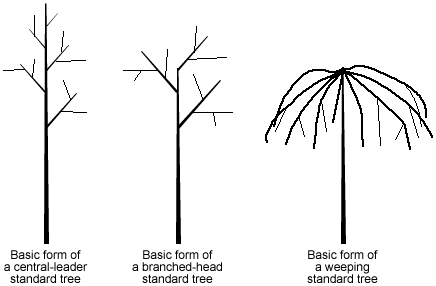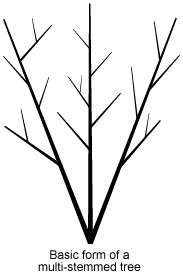Training trees
While it’s perfectly acceptable to allow trees to ‘get on with it’ without human interference (after all, they’ve been doing this for a lot longer than we’ve been fiddling with them!), training a young tree can help ensure you get a well balanced, healthy specimen in the form that you want. Many trees are purchased ready trained (although they may still require training to maintain the work started by the grower), but if you are propagating a tree yourself (eg from a sucker or from seed) or purchase an untrained tree, you will have the opportunity to train it exactly as you want.
Young trees can be purchased at various stages of growth. In their first year of growth (unless they are particularly vigorous) trees consist of upright stems with no lateral growth. These are called ‘maiden whips’ or just ‘whips’. Once some lateral stems have started to grow from the upright stems the tree is known as ‘feathered’, this is usually in the second year of growth.
Training a single stemmed tree
Training in year 1
In the first year of growth allow the tree to grow naturally, not removing any shoots or leaves unless they die or become damaged or diseased. In the winter, select a strong, more or less upright stem to become the central leader of the tree. Stake the stem to a cane which is significantly taller than the tree (so you can continue to use it as the tree lengthens). Ensure that you don’t damage the roots when inserting the cane (either insert the cane before planting the tree, or gently move the soil aside so you can avoid the roots if the tree is already in the ground) and tie the stem to it wrapping the twine around in a figure of eight so the stem won’t rub against the cane. Leave the ties loose enough to allow a bit of movement by the stem. If the central leader’s not growing very well, cut it back to a strong bud, which should then produce vigorous growth to be trained as the leader the following year.
If the leader already has strong lateral growth, shorten this to ensure it doesn’t become dominant over the central leader.
Training in year 2
Continue to prune out any dead, diseased or damaged growth, or any vigorous stems which are competing with the central leader, so that you have a single stem dominating the tree (which should then become a strong trunk). Continue to tie the central leader into the cane at 15-30cm intervals.
If you lose the leader (eg due to physical damage) then prune it back to the first available lateral shoot which is growing more or less upright, or a healthy bud if no lateral growth is available, and train this to replace the original leader. If the buds and shoots grow opposite each other, then remove the bud or shoot growing opposite the one you have chosen as the new leader.
After year 2
At this point you need to decide what form the tree is going to take, and tailor the training accordingly. Below are the main options:
Feathered trees
This is the easiest tree form to produce as you are allowing the tree to grow naturally. The focus of your training should be on keeping the central leader straight and making sure the tree maintains a balanced shape.
Your pruning should aim to remove dead, diseased and damaged growth, any growth which is crossing or congested, any weak growth, and any stems which appear to be competing with the leader.
The tree should be properly staked until it is well established.
Make sure that neighbouring trees, constructions, the wind or shade do not prevent one side of the tree from growing as well, leading to lop-sided growth. It’s generally easier to remove the cause of lop-sided growth than to continually try to correct it by training.
A feathered tree is a good form for deciduous trees and the principle form used for evergreen trees (where the wind resistance of the heavy canopy can make clear trunks susceptible to snapping in strong winds).
Standard trees
A standard tree has a clear trunk with a crown of branches which either still have a strong central leader (a central leader standard) or where the central leader stops at the top of the trunk and the growth above it is all lateral (a branched-head standard). Alternatively the standard may have a weeping form.

In all three cases the trunk of the tree should be cleared of lateral growth. This should be done over a period of 4 years. In the first year, remove all the lateral growth from the bottom third of the trunk and shorten the lateral growth from the middle third of the trunk (by a half). In the second and third years repeat this process, except that the lateral growth in the middle third should be shortened by two-thirds instead of a half. In the fourth year completely remove all lateral growth up to the required height of the trunk. In future years rub out any growth on the cleared trunk as soon as it appears. Additional training is then required depending on the type of standard tree you require:
- Central leader standard trees
Pruning of the top third of the tree should focus on keeping the central leader straight so it grows up vertically through the crown. Pruning of lateral growth from the leader should be kept to the minimum. Any branches competing with the central leader should be removed. If the leader is lost then a suitable stem should be trained to replace it, if necessary attaching a tall cane to the tree’s stake to keep the new leader vertical while it establishes.
- Branched-head standard trees
This replicates what, for many trees, is the natural process of the central leader gradually becoming less dominant until there is just a framework of branches with no leader. This commonly happens with trees such as oaks. Pruning can speed up this process or to create a branched-head form where the tree would not naturally do this. To create a branched-head tree the central leader stem should be cut back to just above the uppermost of three or four strong lateral branches in the third or fourth year of growth. Any lateral growth which is growing vigorously upwards should also be removed in case this becomes a new leader. In the subsequent years, continue to remove any upright growth which looks as if it may become a new leader and shorten the lateral growth as necessary to balance the shape and give the tree an open-centred crown.
- Weeping standard trees
How weeping trees are pruned depends on whether they are a naturally weeping plant or if a weeping top growth has been grafted onto a different rootstock. If the tree is not grafted, and is a naturally weeping form, then little pruning is required, even if the growth appears to be upright instead of weeping – the top growth often grows upwards before bending over into the weeping form. If the tree is grafted then the weeping growth will all be coming from one point, so it can often become tangled, therefore congested growth or stems growing across others should be removed. Upward growth which shows no sign of bending over should also be removed.
Grafted weeping trees may need to remain staked for much longer than non-weeping forms in order to support the more top-heavy growth.
Training a multi-stemmed tree

Trees which produce suckers will naturally grow into this form, unless trained as a single-stemmed standard, but many people like to enhance this appearance by training the tree to just have a few, well spaced main stems. Only some trees can be trained to be multi-stemmed and this training is not appropriate for grafted trees.
To create a controlled multi-stemmed tree start with a two year old tree. Cut the main stem off with a straight cut about 8cm above ground level and trim the edges so there aren’t any rough bits where infections could enter. This should stimulate the stem to produce buds which will grow into new shoots. The following year, select three or four of the most strongly growing stems which are well-spaced, to become the trunks of your tree, and remove all other shoots. In the third year allow lateral growth to develop from the three or four main stems (keeping the trunk clear if wished, in the same way as for a standard tree) and remove any shoots growing from the base of the tree. In subsequent years continue to remove any growth from the base or suckers; this growth will eventually desist.
If you lose one of the main stems then you can select a shoot or sucker from the base of the plant and train this to replace the missing stem.




